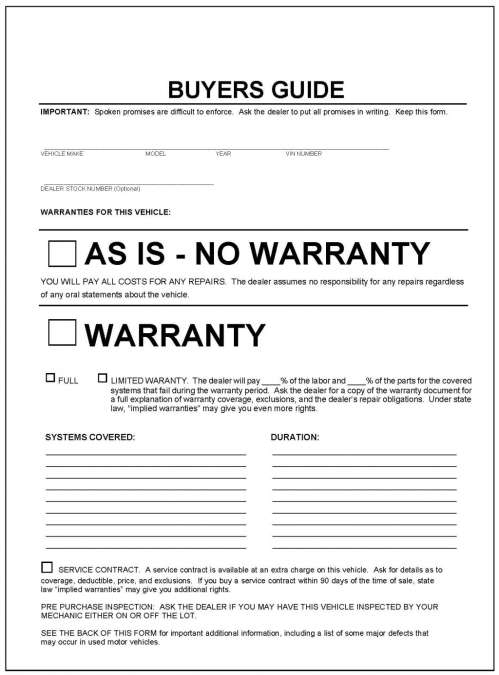For some reason or other, people think it is easy to sell a car. The prevailing thinking is that all you have to do is go online, list the vehicle and your price and wait. The next step is waiting for the offers to roll in.
Car Sales Are Complicated
Duh, would that it was so easy! Ok, why isn’t it? Well, it just isn’t that easy. Let’s start with a simple question: How are you selling the car (or how is the lot where you are looking at the car selling it)? If it is selling “As-Is,” have you made it clear that the vehicle is “As-Is?”
“As-Is” means that the buyer is taking the car from you (or the dealer) as it sits there. If your ad had declared the vehicle – in a private party sale – to be “As-Is” there is nothing the buyer can do. Even if the ball joints have just given in, along with tie rod ends, “As-Is” means that is the way it sells.
If the buyer should then protest that they had no idea that “As-Is” meant the seller was off the hook for any and all problems, there’s nothing that can be done – unless, of course, the seller failed to mention that little fact in the ad or write-up on the vehicle. Then, the shoe is on the other foot. The seller either makes good on the repairs or takes it back from you.
Of course, you – the buyer – may have had more than a few days of aggravation as you went back and forth with the seller as that person tried to twist and turn out of the deal to keep from taking the vehicle back and, worse for many, repaying you.
This is why the Federal Trade Commission’s (FTC) final release of its amended used-car warranty sticker is so important. A required document, the “Buyer’s Guide” is supposed to be prominently displayed on the vehicle, before sale. Like the so-called Monroney sticker that details the car, pricing, and extras, the “Buyer’s Guide” is supposed to give you information that will make your transaction simpler. Of course, while it is required at a dealership (used), however, it makes sense for private parties to know about it, as well. The reason is that if you sell privately, you are still on the hook if the vehicle should be a total lemon. In that instance, there is only one course of action for the private seller and that is giving the buyer the money back. If not, you might be dragged into court and, if the price is high enough, you may find yourself in legal difficulties that could easily be avoided if you’d remembered to use the two words “As-Is” in your ad.
Document Whose Time Has Come
From just about any standpoint the revised FTC document, which is set to go into effect on Jan. 27, 2017, is an enhancement whose time has come. Indeed, it is long overdue. For example, if you were to look at the current “Buyer’s Guide,” you will notice right from the start that it is long. It is two pages of small type that spell out every kind of warranty that might be available to you on a used car that you have purchased from a dealer.
Of course, there’s the “As-Is” sale, where the dealer tells you, “Hey, you are on your own with this beastie – take your chances.” It might work out well and, then again, it might not. In this case, though, since you knew up front that it was an “As-Is” sale, there is very little you can do about it. The dealer has informed you and it is now your responsibility to take care of problems.
The “Buyer’s Guide” revisions have made the document shorter and simpler. The revision is one page and the language it uses is more understandable. The new form presents a very clear, concise description of the “As-Is” sale. The following – warranty – section details what is covered by the manufacturer or dealer if anything or whether there is a third-party warranty available. It may even talk about whether a service contract is accessible to the buyer.
The new document encourages you to visit the FTC website, ftc.gov/usedcars for information on obtaining a vehicle history report (if the dealer doesn’t offer a free CarFax report). And it encourages you to contact the National Highway Traffic Safety Administration’s (NHTSA) website, www.safercar.gov, so you can determine whether there are any outstanding recalls, such as Takata airbags and others.
Spanish “Buyer’s Guide” Available
There are also two unique Spanish language documents, one letting consumers know they can obtain a Spanish copy of the “Buyer’s Guide,” if the deal is going down in Spanish. And, there’s a second that acknowledges the customer has received the document.
The proposed document changes began four years ago. The agency has been gathering comments for that length of time. And, now they are ready to go live with it.
Dealers have a year grace period to use down their existing stocks of “Buyer’s Guides.” After that, they must use the new one.
Sources: Automotive News, thecarconnection.com, Reuters





